10/15/2024 Update – The Casper has been discontinued within the US and replaced with the new Casper One (review here). The Casper is still available for purchase in Canada here.
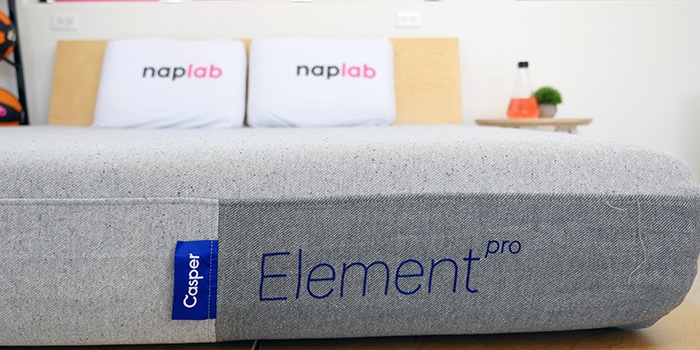
Best For
- A queen mattress under $1000
- Extremely fast response time
- Balanced feel of hug and pushback
Considerations
- Edge support struggles a bit, could pose issues if you often find yourself on the edge
- Moderate heat retention
Our Verdict
The Casper is a 9″ all-foam mattress and uses a combination of poly foam, memory foam, and support foam. It was introduced into the Casper lineup as a budget-friendly alternative to the Casper Original.
It has minimal sinkage and low bounce offering a more balanced contouring hug around the body.
It comes in a single firmness of 6 out of 10, where 10 is the most firm, giving it a medium feel. This makes it a good fit for all body types and sleeping positions.
The Casper achieved an overall score of 8.13, putting it in the bottom 20% of all mattresses we’ve tested to date. Looking specifically at all-foam mattresses, this mattress scores in the bottom 19%.
For a queen mattress, the Casper is $999, 7% less than the average all-foam mattress. While it is cheaper, its performance is also below the average.
The Casper is available for purchase at Casper.com (US) and Casper.ca (Canada).
Type: Foam
Firmness: Medium-Firm (6)
Best For: All Sleeping Positions, All Body Weights
In This Review
Performance Tests | Firmness | Support & Sleeping Positions | Design | Materials | Comparisons | FAQs
In April 2023, Casper renamed the Casper Element Pro into simply “The Casper”. The renamed mattress has a very slightly redesigned cover aesthetic, but in terms of materials it appears to be functionally identical to the Casper Element Pro.
Our review and tests are based on the Element Pro, which we purchased 2 weeks before it was renamed “The Casper”.
Performance Tests
At NapLab, we put each mattress to the test.
We test 10 different factors that impact the performance, comfort, and value of the mattress. We then take the results of that test and compare to every mattress we’ve tested to date.
Check out the full performance table below to see how this mattress ranks:
| Factor | Casper | Average |
|---|---|---|
| Overall Score | 8.13 | 8.55 |
| Price (Queen) | $995 | $1,079 (Foam only) |
| Cooling – Score | 8.0 | 8.7 |
| Sinkage – Depth | 1.75″ | 2.15″ |
| Sinkage – Feel | Minimal | Moderate |
| Motion Transfer – Score | 8.2 | 8.2 |
| Motion Transfer – Acceleration | 8.91 m/s² | 8.79 m/s² |
| Response Time – Score | 9.6 | 8.9 |
| Response Time – Mostly Recovered | 0.2 sec. | 0.4 sec. |
| Response Time – Fully Recovered | 0.8 sec. | 0.9 sec. |
| Bounce – Height | 6.53″ | 9.52″ |
| Bounce – Feel | Low | Moderate |
| Edge Support – Score | 7.7 | 8.6 |
| Edge Support – Sitting | 4.25″ | 4.05″ |
| Edge Support – Lying | Fair | Good |
| Sex – Score | 7.3 | 8.4 |
| Pressure Relief – Score | 8.0 | 8.7 |
| Comfort Layer Thickness | 3.0″ | 4.1″ |
| Mattress Thickness | 9″ | 12.0″ |
| Off-Gassing – Score | 6.7 | 8.2 |
| Off-Gassing – Smell | Strong | Strong |
| Off-Gassing – Days | 12 days | 6 days |
| Company – Score | 9.0 | 8.8 |
| Trial | 100 nights | 178 nights |
| Warranty | 10 years | 25% have lifetime warranties, average of other 75% of mattresses is 13 years |
How is the Casper Different?
The Casper has an overall performance level that is below the average mattress and a price tag that is below average. Compared to the average foam mattress, the Casper is 7% less, for a savings of $80.
Advantages
The Casper had above average performance in response time with a mostly recovered time of 0.2 seconds. Additionally, it matched the average performance in motion transfer.
Neutral Factors
Sinkage and bounce are preferential factors, and both are less than average.
Disadvantages
Concerning where the Casper mattress falls behind, off-gassing was the farthest. Furthermore, cooling, edge support, sex, and pressure relief all fell behind the average.
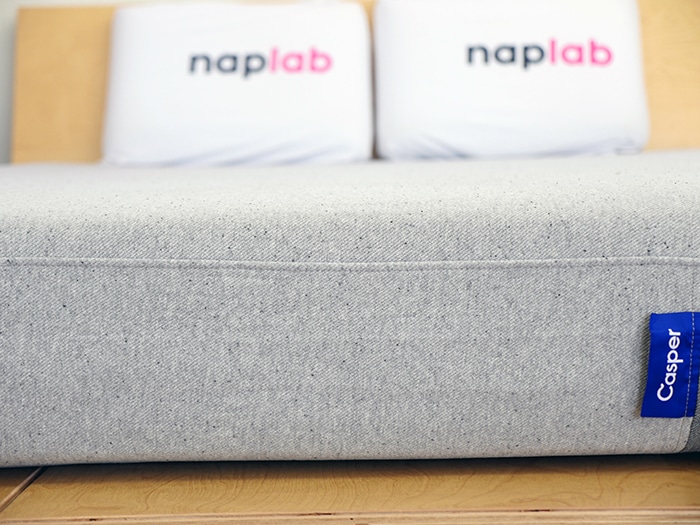
Cooling Test
The cooling performance on the Casper was good, but far from great. During our tests, I experienced a slight to moderate level of heat retention around my body. The heat was mostly isolated to my back, midsection, and butt. Essentially anywhere that sank more deeply into the mattress.
Baseline Temp.
67.3° F
Max Temp.
85.6° F
Ending Temp.
73.5° F
Max Temp.

Ending Temp

- Baseline Temperature – the temperature of the mattress before anyone lies on it
- Maximum Temperature (0 minute) – the temperature of the mattress after lying on it for 15 minutes
- Ending Temperature (5 minute) – the temperature of the mattress after being lied upon and having no one on it for 5 minutes
With the all-foam design, there’s just only so much the mattress can do as far as cooling. The Casper contains no significant specialized cooling cover, cooling foams, and it’s built from 100% foam (no coils).
These factors do the mattress no favors regarding breathability. All that said, I wouldn’t call it a “hot” mattress.
Heat Dissipation Over Time
Even so, many who would describe themselves as “hot” or “warm” sleepers are very likely to find the mattress sleepers too warm for their needs.
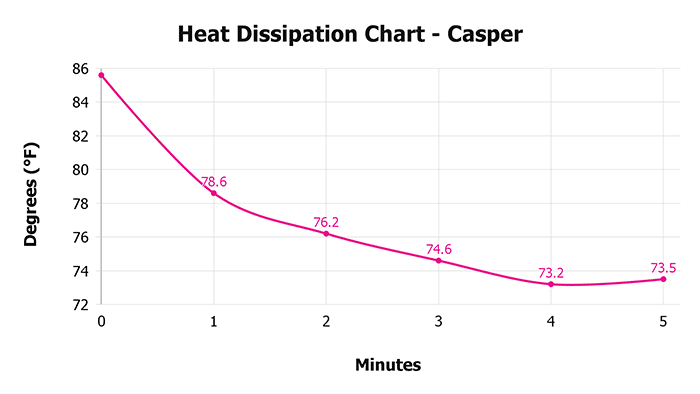
Looking at our objective data, we measured a maximum surface level temperature of 85.6° F. From minutes 0 to 1 the temperature was able to reduce by 7°. And from minutes 0 to 5 the temperature was reduced by 12.1°.
Ultimately, this is a very budget-friendly mattress and sleepers should adjust cooling expectations accordingly.
Sinkage Test
The Casper has a minimal level of sinkage. In our tests, we measured a pressure point sinkage depth of 1.75”. This is 0.4” less than the average of 2.15”.
Sinkage Depth
1.75″
Sinkage Feel
Minimal
Body Contour
Balanced
The level of sinkage is documented in the image below.

The mattress has a more balanced contouring hug around the body. However, it does still lean more in the direction of a memory foam feel.
The foam layers do notably wrap and contour to your unique shape.
However, the top poly foam layer, thinner 3” total comfort layer, and minimal sinkage depth restrain and balance the sharpness of the body contouring hug.
Lighter parts of my body in particular felt that they were floating more on top of the mattress, as opposed to being “in” the mattress (as was the case with the midsection, butt, hips, etc.)
Motion Transfer Test
The Casper has a low level of motion transfer. In our motion transfer tests, we measured a total acceleration range of 8.91 m/s². This is 0.12 m/s² less motion than the average of 8.79 m/s².
Accel. Range
8.91 m/s²
Motion Duration
0.68 seconds
The level of motion transfer is documented in the video below.
Typically, all foam mattresses would have less motion transfer than what we recorded here (foam mattress average motion is 6.44 m/s²).
It’s possible that the minimal level of sinkage provided by the mattress is creating a more abrupt and significant pushback to motion-generating events.
Max. Acceleration
3.55 m/s²
Min. Acceleration
-5.36 m/s²
Accel. Range
8.91 m/s²
If we look at our motion transfer chart, which visualizes our accelerometer data, we can see the highest motion peaks from 0 to 0.14 seconds. Motion drops significantly off thereafter and by 0.68 seconds we have returned to near zero levels.
Motion Transfer Over Time
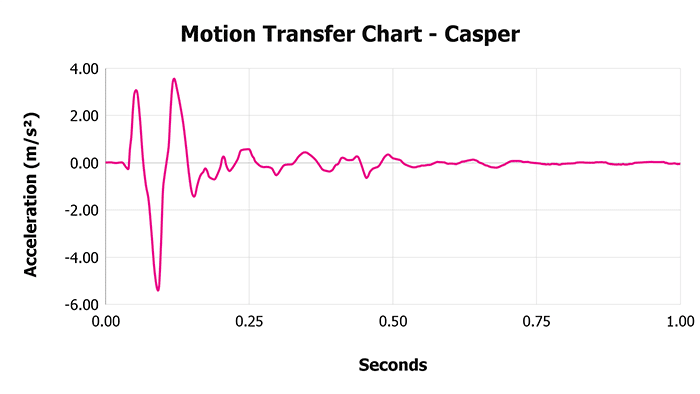
While the motion peaks and valleys are certainly less than ideal, the total motion duration is quite low. By 0.14 seconds motion ranges are less than 2.0 m/s², that’s extremely good.
While more sensitive sleepers could be disturbed by the motion peaks, the motion duration is the silver lining. For many sleepers, I expect this level of motion will be perfectly acceptable.
Response Test
The Casper has extremely fast responsiveness. In our tests, we measured a mostly recovered response time of 0.2 seconds and a fully recovered response time of 0.8 seconds. Both of these are notably faster than the average.
Mostly Recovered
0.2 sec.
Complete Recovery
0.8 sec.
Based on all of our tests to date, we’ve measured an average mostly recovered response time of 0.4 seconds and an average fully recovered response time of 0.9 seconds.
The level of responsiveness is documented in the video below.
At 0.2 seconds to mostly recover, the Casper responses are the same as natural latex. It’s effectively an instant material response.
The fast response is great for improving ease of movement, preventing any type of a “stuck” feeling, and also improving sex performance. Overall, no complaints on my end for material response times.
Bounce Test
The Casper has a low level of bounce. In our tests, we measured a total bounce height of 6.53”. This is 2.99” less bounce than the average of 9.52”.
Max. Depth
4.62″
Max. Rebound
1.91″
Total Bounce
6.53″
Max. Sinkage Depth
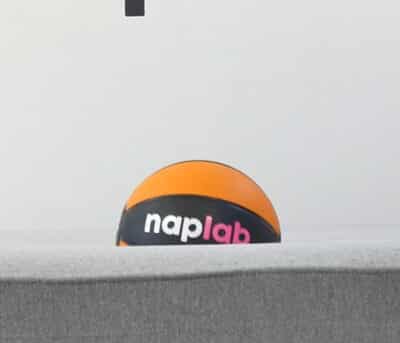
Max Bounce Height

Ideally, I like to see 8-12” of total bounce. This range is a sweet spot that provides the benefits of bounce (ease of movement and sex), while keeping negatives to a minimum (motion and trampoline feel).
The Casper is about 1.5” less than the bottom limiter on my 8-12” ideal bounce range.
The level of bounce is also documented in the video below.
While the lower bounce is very likely helping to keep motion transfer lower, it’s also negatively impacting sex performance. All that said, bounce is more of a preferential factor. Even so, you should be aware that the Casper has less bounce than most mattresses we’ve tested to date.
Edge Support Test
Edge support on the Casper definitely leaves something to be desired. In our sitting edge support tests, we measured 4.25” of total sitting sinkage. This is 0.05” more sinkage than the average of 4.05”.
Max. Sinkage
4.25″
Lying Support
Fair
Reinforced Edge
No
While the Casper does beat out the average, being average is far from ideal. I like to see 4.0” of sitting sinkage or less, with less always being preferred.
When sitting directly on the edge of the mattress I just didn’t feel well supported.
There is a near collapse of materials and the mattress doesn’t support my weight (140 pounds) particularly well.
The level of edge support while seated is documented in the images below.
Sitting, 140 lbs.

Sitting, 200 lbs.

It’s a similar story with lying edge support. The contouring hug of these foams at the very edge creates a more mushy edge. As a result, I don’t feel tremendously well supported at the absolute edge of the mattress.
The level of edge support while lying is documented in the images below.
Lying on Edge, 140 lbs.

Lying on Edge, 200 lbs.

When I am lying on my back it is more noticeable, as the portion of my back closer to the edge is sinking deeper and feels unsupported compared to the portion of my back towards the middle of the mattress.
For most sleepers, just moving a few inches away from the absolute edge can remedy this issue. However, for those who tend to sleep very near / on the edge of the mattress, this could be more of a problem.
Sex Test
The Casper had a fair sex performance.
This mattress has lower levels of bounce and when it comes to sex performance, bounce is critically important. In addition to lower bounce, the edge support is also not great.
| Sex Factor | Factor Weight | Score | Rating |
|---|---|---|---|
| Bounce | 65% | 6.6 | Low |
| Edge Support | 20% | 8.4 | Good |
| Noise | 5% | 10 | Minimal |
| Pressure Relief | 5% | 8.0 | Good |
| Cooling | 5% | 8.0 | Good |

With 4.25″ of sinkage directly at the edge, it may be difficult for the edges to enhance any kind of sexual activity at the edge of the mattress.
Generally, hybrid design mattresses, like the Casper Original Hybrid are going to far outperform the Casper.
Pressure Relief Test
The Casper has good, but far from great pressure relief. In our tests, pressure relief was a bit of a mixed bag.
Comfort Layer
3.0″
Support Layer
6.0″
To talk about pressure relief, let’s first go back to the cooling test. During the cooling test, I lie on my back for 15 minutes. During that test, I felt a moderate level of building pressure in my lower back. In my view, it is the basic material design that limits pressure relief performance on the Casper.
The Casper has just 3.0” of comfort foam. This limited comfort layer results in heavier portions of the body sinking through said comfort layer and coming into more contact with the less pressure-relieving support foam.

This isn’t an issue with the Casper specifically, but rather with most any mattress that contains just 3.0” of comfort material.
Lighter-weight sleepers (especially 120 pounds or less) are more likely to find the pressure relief sufficient.
However, more moderate weighted bodies and heavier weighted sleepers are more likely to sink through the 3.0” comfort layer and thereby experience pressure point issues.
Off-Gassing Test
Off-gassing on the Casper was mediocre and quite a bit worse than average. Straight out of the box the Casper had a strong smell. It took the Casper 12 days to fully dissipate its odor.
On average we see mattresses taking 6.5 days to fully off-gas.
Initial Smell Strength
Strong
Off-Gassing Period
12 days
Casper’s Original & Original Hybrid both had strong off-gassing odors that took even longer to dissipate. It’s possible the specific types of foam Casper is using in their lineup are resulting in the stronger smells.
It’s also possible we simply tested 3 outliers.
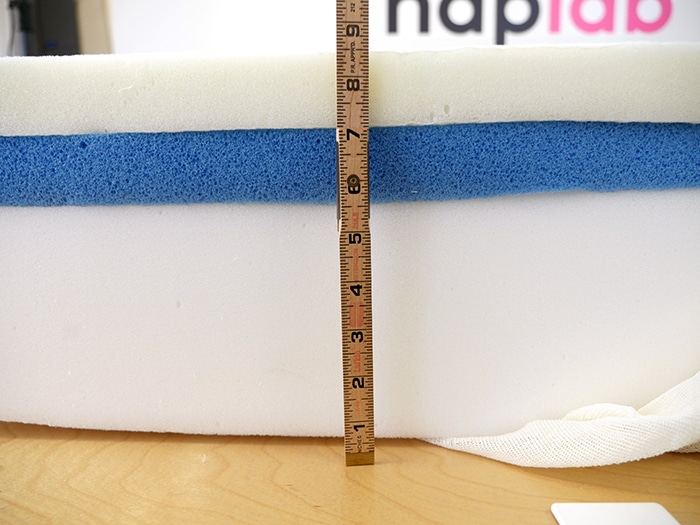
Company
Casper’s company terms and conditions are pretty typical compared to what we see across the industry. They offer a 100-night trial period and a 10-year warranty on any of their mattresses.
| Company Factor | Factor Weight | Score | Data |
|---|---|---|---|
| Returns | 40% | 10 | $0 |
| Trial Period | 30% | 8.0 | 100 nights |
| Warranty | 20% | 8.0 | 10 years |
| Shipping | 10% | 10 | $0 |
| Country of Origin | 0% | USA |
Comparing all mattresses tested to date, the average trial length is 168 nights so Casper’s trial is shorter than average. That being said, 100 nights should still be enough time for you to properly decide if you like the mattress or not.
Comparing all mattresses tested to date, this trial is 44% shorter and the warranty is 3.2 years shorter.
How firm is the Casper?
The Casper mattress has a medium-firm feel, 6 out of 10 on the firmness scale where 10 is the most firm.

This feel is suitable for a wide range of sleepers, being that it is firm enough to support heavier sleepers while also being soft enough for lightweight side sleepers.
Support & Sleeping Positions
The Casper has good, but not great support. As with pressure relief, the limitations on support performance result from the lower profile of the mattress and the limited 3.0” comfort layer.
| Support Factor | Data |
|---|---|
| Comfort Layer | 3.0″ |
| Support Layer | 6.0″ |
| Firmness | Medium-Firm |
| Body Contour | Balanced |
| Zoned Support | Yes |
| Reinforced Edge | No |
During our tests, I felt well-supported in all sleeping positions. However, it is the building pressure relief that impacts support negatively.
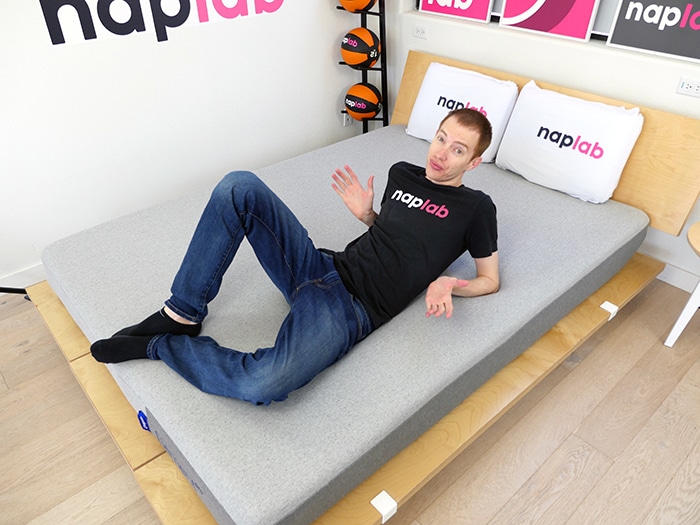
Because the mattress utilizes a 3.0” comfort layer, sleepers are more likely to experience pressure point issues, which will have a negative impact on the support performance of the mattress at large. Furthermore, the 9.0” total thickness of the mattress is worrisome (note – it’s designed to be a 9.5″ mattress, but the version we purchased came in at just 9.0″).
Based on my tests to date, mattresses with 12” or more of total thickness perform significantly better than thinner mattresses, especially when it comes to support.
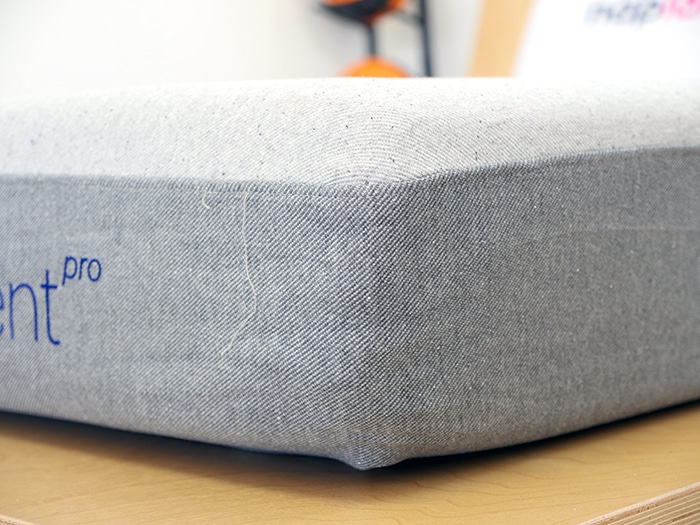
With just 9” of total foam thickness on the Casper sleepers are more likely to sink into the support foams, creating pressure issues, which create support issues.
The heavier the body, the more likely the sleeper will experience issues. As with pressure relief, this isn’t an issue with the Casper specifically, but rather almost all mattresses that are less than 10” thick and use a 3.0” comfort or less.
| Sleeper Weight | Stomach Sleepers | Side Sleepers | Back Sleepers |
|---|---|---|---|
| Under 150 lbs. | Yes | Yes | Yes |
| 150-250 lbs. | Maybe | Maybe | Maybe |
| 250-300 lbs. | No | No | No |
In my view, the support performance will be best for lighter-weight sleepers, while most moderate and heavier-weighted bodies will be better served by other mattresses.
Design
The Casper mattress is a 9″ all-foam mattress with a blend of poly foam, memory foam, and support foam. It has a medium-firm feel and was designed as a budget pick within the Casper lineup.
| Design Factor | Data |
|---|---|
| Type | Foam |
| Thickness | 9.00″ |
| Cover Type | Thin |
| Weight | 76 lbs. |
| Has Handles | No |
| Fiberglass-Free | No |
| Ships in a Box | Yes |
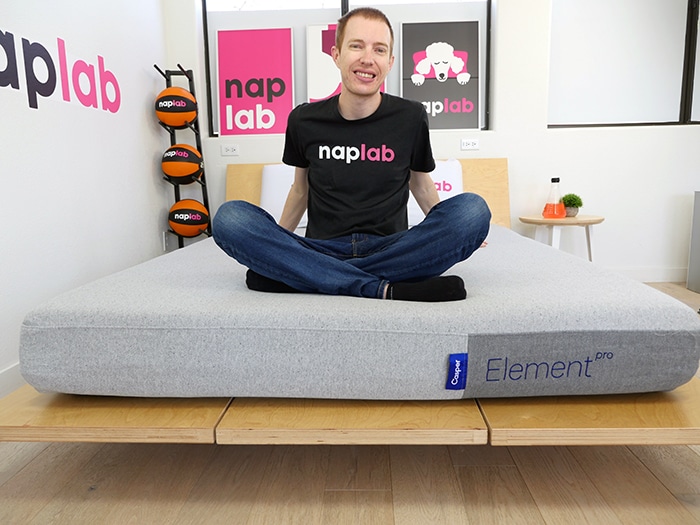
For comparison, the Casper Original is 11″ thick (however, the one we purchased was only 10.5″) and $1295 for a queen. The Casper is 9″ thick and $995. This is a savings of 23%.
Materials
In total, there are three layers with the Casper. There are two comfort layers and one support layer. From top to bottom, these layers are listed below:
| Layer Type | Thickness | Layer Specs |
|---|---|---|
| Poly Foam | 1.5″ | Not Available |
| Memory Foam | 1.5″ | Not Available |
| Support Foam | 6.0″ | Not Available |
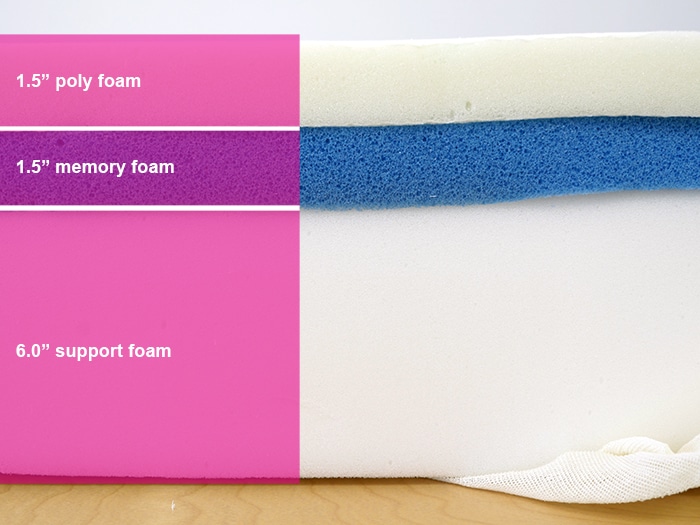
The Cover
The cover of the Casper is soft and stretchy, made of a combination of materials including polyester, cotton, rayon, and Lycra.

It is a hybrid knit weave with a light gray color that incorporates darker specks and nubs throughout the cover.
The Comfort Layer
The comfort layer is made of two layers of foam—a 1.5″ top layer of poly foam followed by a 1.5″ transitional layer of memory foam.
The poly foam layer is perforated, which allows for more airflow to pass through these layers.
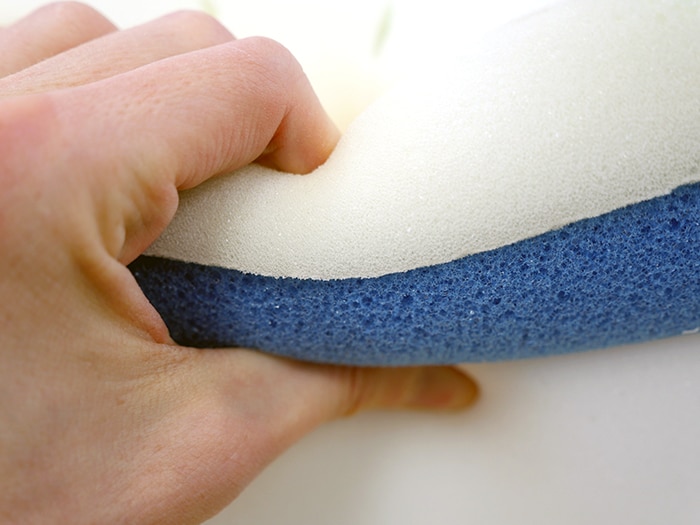
Both of these layers work together to provide comfort and ease the transition into the support layer below.
The Support Layer
The support layer at the base of the mattress is a 6.0″ layer slab of high-density support foam. This foam provides the shape for the mattress and supports the layers above.
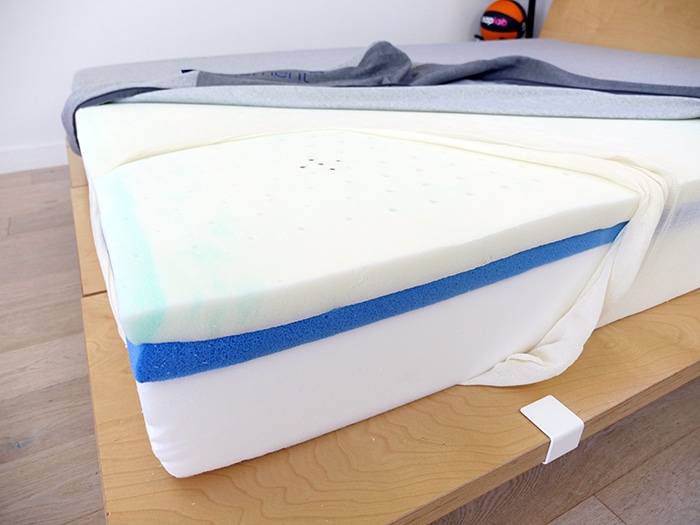
Product Evolution
The Casper was launched April 2023 as the 4th generation of budget conscious mattress options by Casper. First came the Casper Essential in 2017 followed by the Casper Element in 2020.
In 2022, Casper launched the Casper Element Pro, which was discontinued in April 2023. The Element Pro was replaced by a “new” mattress simply called “The Casper”. This new mattress appears to be functionally identical to the Casper Element Pro.
The only major difference (as far as we can ascertain) is that Casper has a slightly different cover (aesthetic update only) compared to the Casper Element Pro.

All four of these mattresses were released as a budget alternative to the Casper Original, Casper’s first mattress that launched in 2014.
In 2020, Casper expanded their collection even more by also releasing more advanced mattresses like the Casper Wave, the Casper Nova, and the Casper Snug (which was later discontinued).
In April 2023, Casper further expanded their collection with the addition of the Casper Snow mattress.
Other Mattresses to Consider
Not sure that the Casper is the right pick for you? Check out these 3 other top-rated foam alternatives you might want to consider.
For Performance

Douglas
Canadian Made
The Douglas mattress is a 10″ high foam mattress with 4.0″ of comfort foam. Compared to the Casper, Douglas offers improved pressure relief, cooling, and edge support. These improvements come at a lower price as well.
For Pressure Relief
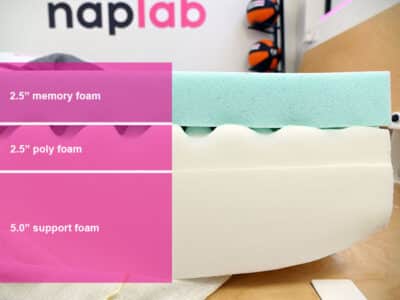
Siena
Amazing Price
The Siena is a 10″ high foam mattress that devotes 5″ of the total mattress height to comfort material. If you want better pressure relief without a bigger budget, the Siena is a great choice.
For Firmness
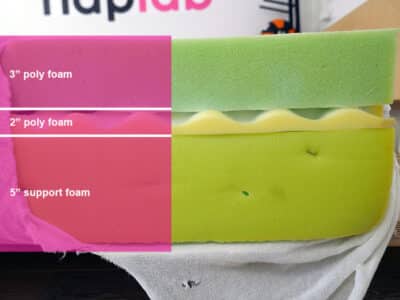
Nest Bedding Quail
Similar Feel
The Nest Bedding Quail has a 10″ thickness and the added benefit of being available in two firmness levels. For something softer than the Casper, try the Quail Medium or for something firmer, opt for the Quail Lux Firm.
Frequently Asked Questions
Still have questions? Check out some of the top FAQs on the Casper mattress below and get the answers you’re looking for.
Here are the current prices, with any sales or promotions reflected below:
Twin: $595
Twin XL: N/A
Full: $895
Queen: $995
King: $1395
Cal. King: N/A
*Note: Sales prices are subject to change without notice or warning.
Yes, the Element (launched in 2020) was replaced by the Element Pro, (released in 2022).
Yes, the Element Pro (launched in 2022) was discontinued in April 2023. It was replaced by the “The Casper”, a “new” mattress that appears to be functionally identical to the Casper Element Pro. “The Casper” does have a slightly redesigned cover compared to the Element Pro.
No, the Casper Essential was launched in 2017 as a budget-friendly alternative to the Casper Original. The Element Pro is a redesigned version of the Casper Essential, but there are some notable differences between these two versions.
Disclosure – Derek Hales has a history with Casper that some may view as relevant to his reviews of Casper products. In 2016, Casper Sleep sued Derek Hales in federal court over his reviews of its products. In 2017, the lawsuit ended with a settlement. See here for more information.



